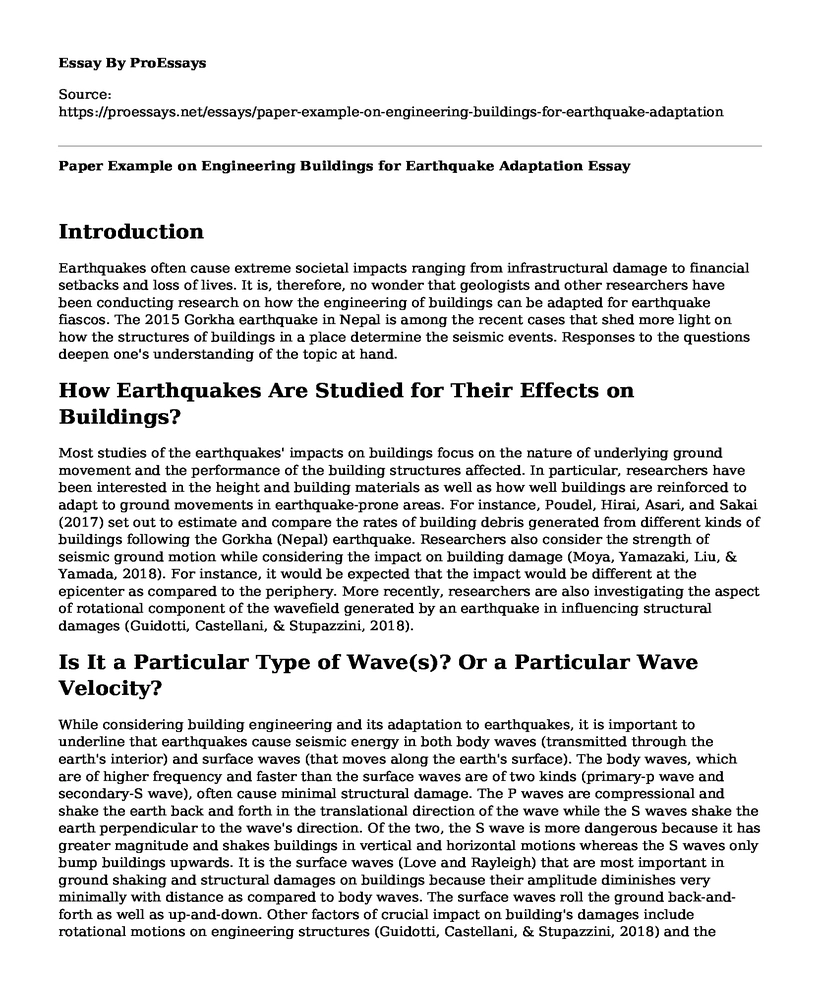Introduction
Earthquakes often cause extreme societal impacts ranging from infrastructural damage to financial setbacks and loss of lives. It is, therefore, no wonder that geologists and other researchers have been conducting research on how the engineering of buildings can be adapted for earthquake fiascos. The 2015 Gorkha earthquake in Nepal is among the recent cases that shed more light on how the structures of buildings in a place determine the seismic events. Responses to the questions deepen one's understanding of the topic at hand.
How Earthquakes Are Studied for Their Effects on Buildings?
Most studies of the earthquakes' impacts on buildings focus on the nature of underlying ground movement and the performance of the building structures affected. In particular, researchers have been interested in the height and building materials as well as how well buildings are reinforced to adapt to ground movements in earthquake-prone areas. For instance, Poudel, Hirai, Asari, and Sakai (2017) set out to estimate and compare the rates of building debris generated from different kinds of buildings following the Gorkha (Nepal) earthquake. Researchers also consider the strength of seismic ground motion while considering the impact on building damage (Moya, Yamazaki, Liu, & Yamada, 2018). For instance, it would be expected that the impact would be different at the epicenter as compared to the periphery. More recently, researchers are also investigating the aspect of rotational component of the wavefield generated by an earthquake in influencing structural damages (Guidotti, Castellani, & Stupazzini, 2018).
Is It a Particular Type of Wave(s)? Or a Particular Wave Velocity?
While considering building engineering and its adaptation to earthquakes, it is important to underline that earthquakes cause seismic energy in both body waves (transmitted through the earth's interior) and surface waves (that moves along the earth's surface). The body waves, which are of higher frequency and faster than the surface waves are of two kinds (primary-p wave and secondary-S wave), often cause minimal structural damage. The P waves are compressional and shake the earth back and forth in the translational direction of the wave while the S waves shake the earth perpendicular to the wave's direction. Of the two, the S wave is more dangerous because it has greater magnitude and shakes buildings in vertical and horizontal motions whereas the S waves only bump buildings upwards. It is the surface waves (Love and Rayleigh) that are most important in ground shaking and structural damages on buildings because their amplitude diminishes very minimally with distance as compared to body waves. The surface waves roll the ground back-and-forth as well as up-and-down. Other factors of crucial impact on building's damages include rotational motions on engineering structures (Guidotti, Castellani, & Stupazzini, 2018) and the aftershock events (Ilyas, Azeem, & Mohiuddin, 2018).
What Characteristics of the Buildings Make Them More/Less Likely to Collapse During an Earthquake?
The architecture of a building determines the destruction it undergoes in the event of an earthquake. As established from the 2015 Gorkha earthquake in Nepal building with weak structures are more likely to collapse during an earthquake as compared to buildings with stronger foundations. Wooden buildings are at the highest risk. Similarly, buildings with brittle concrete columns are more likely to collapse than those with stronger concrete columns. In this light, Zucconi, Ferlito, and Sorrentino (2018) show that unreinforced masonry buildings are at increased risk as compared with those with reinforced structures. The height of a building and shape of a building also affects the risk of destruction, with those with more than two storeys in earthquake-prone areas at higher risk especially if their ground and the first floor is weak.
Do Regulations Matter?
Retrospectively, regulations go a long way in reducing the risk of structural damage due to earthquakes. Buildings that conform to strict reinforced building codes would suffer minimal damage because they are adapted to withstand earthquake events.
Conclusion
To conclude, the engineering of buildings is critical in influencing the damages they incur in the event of an earthquake. Whereas the destructiveness of an earthquake is determined by the seismic waves' magnitude, particularly the amplitude of surface waves, building materials, shape and height of a structure influences its risk of damage from ground movements. Governments ought to map out and declare earthquake-prone areas and enforce favorable building codes that would reduce structural damage during earthquakes.
References
Guidotti, R., Castellani, A., and Stupazzini, M. (2018). Near-field earthquake strong ground motion rotations and their relevance on tall buildings. Bulletin of the Seismological Society of America, 108(3), 1171-1184.
Ilyas, A., Azeem, M., and Mohiuddin, H. (2018). Seismic response of reinforced concrete buildings under mainshock - Aftershock earthquake sequence. International Journal of Civil Engineering and Technology, 9(4), 647-659.
Moya, L., Yamazaki, F., Liu, W., and Yamada, M. (2018). Detection of collapsed buildings from lidar data due to the 2016 Kumamoto earthquake in Japan. Natural Hazards and Earth System Sciences, 18(1), 65-78.
Poudel, R., Hirai, Y., Asari, M., Sakai, S. (2018). Establishment of unit generation rates of building debris in Kathmandu Valley, Nepal, after the Gorkha earthquake. The Journal of Material Cycles and Waste Management, 20, 1663-1675.
Zucconi, M., Ferlito, R., and Sorrentino, L. (2018). Simplified survey form of unreinforced masonry buildings calibrated on data from the 2009 L'Aquila earthquake. Bulletin of Earthquake Engineering, 16(7), 2877-2911.
Cite this page
Paper Example on Engineering Buildings for Earthquake Adaptation. (2022, Jun 29). Retrieved from https://proessays.net/essays/paper-example-on-engineering-buildings-for-earthquake-adaptation
If you are the original author of this essay and no longer wish to have it published on the ProEssays website, please click below to request its removal:
- Climate and Disaster Resilience Essay
- Research Paper on Dealing With Climate Changes and Global Warming
- Engineer's Professional and Technical Competencies Paper Example
- Paper Example on Aircraft Cockpit: Evolution Over Time
- Essay Example on Public Health & Climate Change: Identifying Populations at Risk
- Paper Sample: Fresh Graduate Pursues Master's in Electrical Engineering at KFUPM
- Free Essay Example on Social Engineering and how it applies to Coronavirus Pandemic







